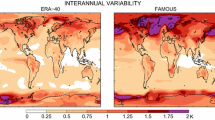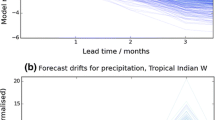Abstract
A set of four ensemble simulations has been designed to assess the relative importance of atmospheric, oceanic, and deep ocean initial state uncertainties, as represented by spatial white noise perturbations, on seasonal to decadal prediction skills in a perfect model framework. It is found that a perturbation mimicking random oceanic uncertainties have the same impact as an atmospheric-only perturbation on the future evolution of the ensemble after the first 3 months, even if they are initially only located in the deep ocean. This is due to the fast (1 month) perturbation of the atmospheric component regardless of the initial ensemble generation strategy. The divergence of the ensemble upper-ocean characteristics is then mainly induced by ocean–atmosphere interactions. While the seasonally varying mixed layer depth allows the penetration of the different signals in the thermocline in the mid-high latitudes, the rapid adjustment of the thermocline to wind anomalies followed by Kelvin and Rossby waves adjustment dominates the growth of the ensemble spread in the tropics. These mechanisms result in similar ensemble distribution characteristics for the four ensembles design strategy at the interannual timescale.








Similar content being viewed by others
References
Abraham JP, Baringer M, Bindoff NL, Boyer T, Cheng LJ, Church JA, Conroy JL, Domingues CM, Fasullo JT, Gilson J, Goni G, Good SA, Gorman JM, Gouretski V, Ishii M, Johnson GC, Kizu S, Lyman JM, Macdonald AM, Minkowycz WJ, Moffitt SE, Palmer MD, Piola AR, Reseghetti F, Schuckmann K, Trenberth KE, Velicogna I, Willis JK (2013) A review of global ocean temperature observations: implications for ocean heat content estimates and climate change. Rev Geophys 51(3):450–483. doi:10.1002/rog.20022
Aumont O, Bopp L (2006) Globalizing results from ocean in situ iron fertilization studies. Glob Biogeochem Cycles 20, GB2017. doi:10.1029/2005GB002591
Baehr J, Piontek R (2014) Ensemble initialization of the oceanic component of a coupled model through bred vectors at seasonal-to-interannual timescales. Geosci Model Dev 7(1):453–461. doi:10.5194/gmd-7-453-2014
Bellucci A, Gualdi S, Masina S, Storto A, Scoccimarro E, Cagnazzo C, Fogli P, Manzini E, Navarra A (2013) Decadal climate predictions with a coupled OAGCM initialized with oceanic reanalyses. Clim Dyn 40(5–6):1483–1497. doi:10.1007/s00382-012-1468-z
Born A, Mignot J, Stocker T (2015) Multiple equilibria as a possible mechanism for decadal variability in the North Atlantic Ocean. J Clim 28:8907–8922
Branstator G, and Teng H (2010) Two limits of initial-value decadal predictability in a CGCM. Journal of climate 23(23):6292–6311.doi:10.1175/2010JCLI3678.1
Bretherton CS, Widmann M, Dymniko VP, Wallace JM, Bladé I (1999) The effective number of spatial degrees of freedom of a time-varying field. J Clim 12:1990–2009
Buchan J, Hirschi JJM, Blaker AT, Sinha B (2014) North Atlantic SST anomalies and the cold North European weather events of winter 2009/10 and December 2010. Mon Weather Rev 142(2):922–932. doi:10.1175/MWR-D-13-00104.1
Buizza R (2010) Horizontal resolution impact on short-and long-range forecast error. Q J R Meteorol Soc 136(649):1020–1035. doi:10.1002/qj.613
Collins M, Botzet M, Carril AF, Drange H, Jouzeau A, Latif M, Masina S, Otteraa AH, Pohlmann H, Sorteberg A, Sutton R, Terray L (2006) Interannual to decadal climate predictability in the North Atlantic: a multimodel-ensemble study. J Clim 19(7):1195–1203. doi:10.1175/JCLI3654.1
Du H, Doblas-Reyes FJ, García-Serrano J, Guemas V, Soufflet Y, Wouters B (2012) Sensitivity of decadal predictions to the initial atmospheric and oceanic perturbations. Clim Dyn 39(7–8):2013–2023. doi:10.1007/s00382-011-1285-9
Dufresne JL, Foujols M-A, Denvil M-AS, Caubel A, Marti O, Aumont O, Balkanski Y, Bekki S, Bellenger H, Benshila R, Bony S, Bopp L, Braconnot P, Brockmann P, Cadule P, Cheruy F, Codron F, Cozic A, Cugnet D, de Noblet N, Duvel J-P, Ethé C, Fairhead L, Fichefet T, Flavoni S, Friedlingstein P, Grandpeix J-Y, Guez L, Guilyardi E, Hauglustaine D, Hourdin F, Idelkadi A, Ghattas J, Joussaume S, Kageyama M, Krinner G, Labetoulle S, Lahellec A, Lefebvre M-P, Lefevre F, Levy C, Li ZX, Lloyd J, Lott F, Madec G, Mancip M, Marchand M, Masson S, Meurdesoif Y, Mignot J, Musat I, Parouty S, Polcher J, Rio C, Schulz M, Swingedouw D, Szopa S, Talandier C, Terray P, Viovy N, Vuichard N (2013) Climate change projections using the IPSL-CM5 Earth System Model: from CMIP3 to CMIP5. Clim Dyn 40(9–10):2123–2165. doi:10.1007/s00382-012-1636-1
Fichefet T, Maqueda MAM (1997) Sensitivity of a global sea ice model to the treatment of ice thermodynamics and dynamics. J Geophys Res 102:2609–2612
Goldenberg SB, Landsea CW, Mestas-Nuñez AM, Gray WM (2001) The recent increase in Atlantic hurricane activity: causes and implications. Science 293(5529):474–479. doi:10.1126/science.1060040
Griffies SM, Bryan K (1997) A predictability study of simulated North Atlantic multidecadal variability. Clim Dyn 13(7–8):459–487. doi:10.1007/s003820050177
Ham YG, Rienecker MM, Suarez MJ, Vikhliaev Y, Zhao B, Marshak J, Verniere G, Schubert SD (2014) Decadal prediction skill in the GEOS-5 forecast system. Clim Dyn. doi:10.1007/s00382-013-1858-x
Hanawa K, Talley LD (2001) Mode waters. Int Geophys Ser 77:373–386
Hazeleger W, Wouters B, Oldenborgh GJ, Corti S, Palmer T, Smith D, Storch JS (2013) Predicting multiyear north atlantic ocean variability. J Geophys Res 118(3):1087–1098. doi:10.1002/jgrc.20117
Hourdin F, Foujols M-A, Codron F (2013) Impact of the LMDZ atmospheric grid configuration on the climate and sensitivity of the IPSL-CM5A coupled model. Clim Dyn. doi:10.1007/s00382-012-1411-3
Johnson E, McPhaden MJ (1993) Structure of intraseasonal Kelvin waves in the equatorial Pacific Ocean. J Phys Oceanogr 23:608–625. doi:10.1175/1520-0485(1993)023<0608:SOIKWI>2.0.CO;2
Karspeck AR, Stammer D, Köhl A, Danabasoglu G, Balmaseda M, Smith DM, Fujii Y, Zhang S, Giese B, Tsujino H, Rosati A (2015) Comparison of the Atlantic meridional overturning circulation between 1960 and 2007 in six ocean reanalysis products. Clim Dyn. doi:10.1007/s00382-015-2787-7
Keenlyside NS, Latif M, Jungclaus J, Kornblueh L, Roeckner E (2008) Advancing decadal-scale climate prediction in the North Atlantic sector. Nature 453(7191):84–88
Kennedy JJ (2014) A review of uncertainty in in situ measurements and data sets of sea surface temperature. Rev Geophys 52(1):1–32. doi:10.1002/2013RG000434
Kessler WS, McPhaden JM, Weickmann KM (1995) Forcing of intraseasonal Kelvin waves in the equatorial Pacific. J Geophys Res 100(C6):10–613
Kirtman B, Power SB, Adedoyin JA, Boer GJ, Bojariu R, Camilloni I, Doblas-Reyes FJ, Fiore AM, Kimoto M, Meehl GA, Prather M, Sarr A, Schär C, Sutton R, van Oldenborgh GJ, Vecchi G, Wang HJ (2013) Near-term climate change: projections and predictability. In: Stocker TF, Qin D, Plattner G-K, Tignor M, Allen SK, Boschung J, Nauels A, Xia Y, Bex V, Midgley PM (eds) Climate change 2013: the physical science basis. Contribution of working group I to the fifth assessment report of the intergovernmental panel on climate change. Cambridge University Press, Cambridge
Kolodziejczyk N, Reverdin G, Lazar A (2015) Interannual variability of the mixed layer winter convection and spice injection in the eastern subtropical North Atlantic. J Phys Oceanogr 45(2):504–525
Kröger J, Müller WA, Von Storch JS (2012) Impact of different ocean reanalyses on decadal climate prediction. Clim Dyn 39:795–810. doi:10.1007/s00382-012-1310-7
Lorenz EN (1963) Deterministic nonperiodic flow. J Atmos Sci 20(2):130–141
Lorenz EN (1969) Atmospheric predictability as revealed by naturally occurring analogues. J Atmos Sci 26(4):636–646
Madec G (2008) NEMO ocean engine, Technical note, IPSL. Available at http://www.nemo-ocean.eu/content/download/11245/56055/file/NEMO_book_v3_2.pdf
McCarthy GD, Haigh ID, Hirschi JJM, Grist JP, Smeed DA (2015) Ocean impact on decadal Atlantic climate variability revealed by sea-level observations. Nature 521(7553):508–510. doi:10.1038/nature14491
Mignot J, Swingedouw D, Deshayes J, Marti O, Talandier C, Séférian R, Lengaigne M, Madec G (2013) On the evolution of the oceanic component of the IPSL climate models from CMIP3 to CMIP5: a mean state comparison. Ocean Model 72:167–184. doi:10.1016/j.ocemod.2013.09.001
Mignot J, Garcia-Serrano J, Swingedouw D, Germe A, Nguyen S, Ortega P, Guilyardi E, Ray S (2015) Decadal prediction skill in the ocean with surface nudging in the IPSL-CM5A-LR climate model. Clim Dyn. doi:10.1007/s00382-015-2898-1
Msadek R, Dixon KW, Delworth TL, Hurlin W (2010) Assessing the predictability of the Atlantic meridional overturning circulation and associated fingerprints. Geophys Res Lett. doi:10.1029/2010GL044517
Müller WA, Pohlmann H, Sienz F, Smith D (2014) Decadal climate predictions for the period 1901–2010 with a coupled climate model. Geophys Res Lett 41(6):2100–2107. doi:10.1002/2014GL059259
Ortega P, Mignot J, Swingedouw D, Sévellec F, Guilyardi E (2015) Reconciling two alternative mechanisms behind bi-decadal variability in the North Atlantic. Prog Oceanogr 137:237–249. doi:10.1016/j.pocean.2015.06.009
Peings Y, Magnusdottir G (2014) Forcing of the wintertime atmospheric circulation by the multidecadal fluctuations of the North Atlantic ocean. Environ Res Lett 9(3):034018. doi:10.1088/1748-9326/9/3/034018
Persechino A, Mignot J, Swingedouw D, Labetoulle S, Guilyardi E (2013) Decadal predictability of the Atlantic meridional overturning circulation and climate in the IPSL-CM5A-LR model. Clim Dyn 40(9–10):2359–2380. doi:10.1007/s00382-012-1466-1
Philander SGH, Yamagata T, Pacanowski RC (1984) Unstable air–sea interactions in the tropics. J Atmos Sci 41:604–613. doi:10.1175/1520-0469(1984)041<0604:UASIIT>2.0.CO;2
Pohlmann H, Botzet M, Latif M, Roesch A, Wild M, Tschuck P (2004) Estimating the decadal predictability of a coupled AOGCM. J Clim 17(22):4463–4472. doi:10.1175/3209.1
Pohlmann H, Smith DM, Balmaseda MA, Keenlyside NS, Masina S, Matei D, Müller WA, Rogel P (2013) Predictability of the mid-latitude Atlantic meridional overturning circulation in a multi-model system. Clim Dyn 41(3–4):775–785. doi:10.1007/s00382-013-1663-6
Ray S, Swingedouw D, Mignot J, Guilyardi E (2014) Effect of surface restoring on subsurface variability in a climate model during 1949–2005. Clim Dyn. doi:10.1007/s00382-014-2358-3
Romanova V, Hense A (2015) Anomaly transform methods based on total energy and ocean heat content norms for generating ocean dynamic disturbances for ensemble climate forecasts. Clim Dyn. doi:10.1007/s00382-015-2567-4
Sanchez-Gomez E, Cassou C, Ruprich-Robert Y, Fernandez E, Terray L (2015) Drift dynamics in a coupled model initialized for decadal forecasts. Clim Dyn. doi:10.1007/s00382-015-2678-y
Séférian R, Bopp L, Gehlen M, Orr JC, Ethé C, Cadule P, Aumont O, Salas y Mélia D, Voldoire A, Madec G (2013) Skill assessment of three earth system models with common marine biogeochemistry. Clim Dyn 40(9–10):2549–2573. doi:10.1007/s00382-012-1362-8
Servonnat J, Mignot J, Guilyardi E, Swingedouw D, Séférian R, Labetoulle S (2014) Reconstructing the subsurface ocean decadal variability, using surface nudging in a perfect model framework. Clim Dyn. doi:10.1007/s00382-014-2184-7
Sévellec F, Fedorov AV (2013) Model bias reduction and the limits of oceanic decadal predictability: importance of the deep ocean. J Clim 26(11):3688–3707. doi:10.1175/JCLI-D-12-00199.1
Smith DM, Cusack S, Colman AW, Folland CK, Harris GR, Murphy JM (2007) Improved surface temperature prediction for the coming decade from a global climate model. Science 317(5839):796–799. doi:10.1126/science.1139540
Stan C, Kirtman BP (2008) The influence of atmospheric noise and uncertainty in ocean initial conditions on the limit of predictability in a coupled GCM. J Clim 21(14):3487–3503. doi:10.1175/2007JCLI2071.1
Stockdale TN, Anderson DLT, Alves JOS, Balmaseda MA (1998) Global seasonal rainfall forecasts using a coupled ocean–atmosphere model. Nature 392(6674):370–373. doi:10.1038/32861
Sutton RW, Dong B (2012) Atlantic Ocean influence on a shift in European climate in the 1990s. Nat Geosci. doi:10.1038/ngeo1595
Sutton RT, Hodson DL (2005) Atlantic Ocean forcing of North American and European summer climate. Science 309(5731):115–118. doi:10.1126/science.1109496
Swingedouw D, Mignot J, Labetoulle S, Guilyardi E, Madec G (2013) Initialisation and predictability of the AMOC over the last 50 years in a climate model. Clim Dyn 40(9–10):2381–2399. doi:10.1007/s00382-012-1516-8
Valcke S (2006) OASIS3 user guide (prism_2-5), technical report TR/CMGC/06/73, PRISM report no 2. CERFACS, Toulouse, p 60
Zhang R, Delworth TL (2006) Impact of Atlantic multidecadal oscillations on India/Sahel rainfall and Atlantic hurricanes. Geophys Res Lett. doi:10.1029/2006GL026267
Acknowledgments
The data used in this study are freely available: the authors can send them upon request. This work has been funded by the European community 7th framework programme (FP7) through the SPECS (Seasonal-to-decadal climate Prediction for the improvement of Climate Service) project under Grant agreement 308378 and by the Natural and Environmental Research Council UK (MESO-CLIP, NE/K005154/1 and SMURPHS, NE/N005767/1). We also thank the TGCC for computing resources and the IPSL model pole. The authors would like to thank Pablo Ortega and Javier Garcia-Serrano for helpful discussions and two reviewers for there helpful comment on the manuscript. They also thank J. Annan and W. Connolley for interesting exchanges about their experiment with HadCAM3. A.G. also wishes to thank the University of Southampton and the National Oceanography Centre Southampton and especially the PO and MSM teams for their welcome and the facilities they provided in order to help collaboration.
Author information
Authors and Affiliations
Corresponding author
Rights and permissions
About this article
Cite this article
Germe, A., Sévellec, F., Mignot, J. et al. On the robustness of near term climate predictability regarding initial state uncertainties. Clim Dyn 48, 353–366 (2017). https://doi.org/10.1007/s00382-016-3078-7
Received:
Accepted:
Published:
Issue Date:
DOI: https://doi.org/10.1007/s00382-016-3078-7




